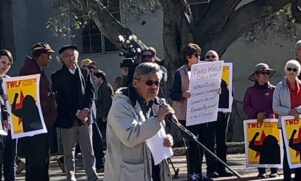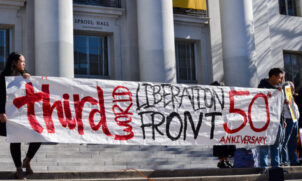
FOR THE LATINX RESEARCH CENTER, UNIVERSITY OF CALIFORNIA, BERKELEY
By Harvey Dong
The Future of Ethnic Studies on Its 50th Anniversary: Autonomy and Self-Determination Are Missing
(Originally submitted to the Department of Ethnic Studies, UC Berkeley Newsletter–50th Anniversary Spring 2018 Issue)
Ethnic Studies at Berkeley remains an unfinished struggle that began almost 50 years ago with the TWLF Strike in 1969. Fundamental questions still remain over program autonomy and direction. Autonomy refers to the the right to program control based upon the needs of students and their communities. Successive generations of students seeking to resist inequality and oppression, continue to look towards Ethnic Studies relevance as they are confronted with white supremacy, nativism and racism. But student of color actions are often viewed by the campus administration as impatience, unrealistic and harmful to the academic environment.
It can be stated unequivocally that Ethnic Studies exists because of the solidarity and struggle of students supported by faculty and community. The issues of autonomy and self-determination has been the heart of the long protracted 50 year history of Ethnic Studies. Throughout the history of Ethnic Studies, administrative responses at every level of historical development has been to weaken autonomy. Likewise, it is important for every generation of students and entering faculty to understand that student involvement and community engagement has been the lifeblood of the department.
From the beginning in 1969, university administration denial of program autonomy for the African American Studies proposal led the Afro-American Students Union (AASU) to propose the idea of a TWLF coalition and strike to the Chicano, Asian American and Native American student groups (MASC [Mexican American Student Confederation], AAPA [Asian American Political Alliance], NASU [Native American Students United]) who were also engaging in similar talks with the administration to start their own programs. These groups were willing to join in coalition because they too anticipated deadlocked negotiations with the administration; held common cause with the AASU over the issue of autonomy and saw the necessity for a student strike to establish a Third World College in 1969.
After the strike, the interim Department of Ethnic Studies, undergoing discussion to transition into its own college, would again find itself continually struggling with administrative pressures that would eventually end their pursuit towards establishment of a college. First was the departure of African American Studies, from the interim Ethnic Studies Department, into the College of Letters & Science (L&S) as its own department. Second, the departure of African American Studies in 1974 put Ethnic Studies into an existential crisis. To fill the void of the departure, Ethnic Studies transferred teaching resources into a separate Comparative Ethnic Studies major with resources reallocated from the remaining Asian American, Chicano and Native American Studies major programs. This in turn depleted the FTE funds from the community-based programs that were part of each major. Despite lack of funding support, Ethnic Studies still became a recognized academic leader in the study of race and ethnicity.
20 years later, the Ethnic Studies also followed African American Studies into L&S becoming a department with the hopes that there would be more resources, funding and support. The resources did not appear and the department waned from benign neglect under L&S. Instead of being placed in a better position, Ethnic Studies was severely cut back–retired professors were not being replaced, budget, staff and classes suffered severe funding cuts.
It was only through the efforts of the 1999 twLF student coalition that pushed back this development and saved Ethnic Studies for the short term–gaining 8 faculty FTE positions, establishment of the Center For Race & Gender, funding for student recruitment and retention programs, the opening of the Multicultural Community Center and a mural in Barrows Hall to commemorate the struggle for Ethnic Studies. The 1999 twLF student efforts regained lost ground and revitalized Ethnic Studies. Faculty support for this was critical including vocal support from Ethnic Studies and African American Studies faculty, as well as widespread community support during the several weeks of a hunger strike, rallies and police arrests.
Today, it is still an unfinished struggle: a departure from the original idea of a full college with developed departments, community-based programs; with student and community advisory input. Budget cuts have whittled away department and program funding. We are managed as a cluster by L&S but there is no decision input from the below. Instead of more courses, there are less. In comparing the total numbers of Asian American Studies courses offered in 1970 with the numbers offered in Spring 2018, there remains ironically the same number offered: 11. There were 11 instructors listed to teach Asian (American) Studies in 1970 and 11 listed today teaching Asian American & Asian Diaspora Studies (AAADS). A similar situation exists in the other programs.
The idea of a college is not a pipedream. It exists at San Francisco State University. Ethnic Studies exists there not as a department but as college with its own deans. Their existence was also the result of struggle and solidarity. This Spring 2018 semester, course offerings at SFSU are much higher than UCB’s Spring 2018 semester offerings. Asian American Studies at SFSU has 28 classes, Latino/a American Studies has 31 classes, American Indian Studies has 13 classes, Race and Resistance Studies has 23 classes, Africana Studies has 23 classes. In addition, Arab and Muslim Ethnicities and Diaspora Studies at SFSU is newly established. In comparison, the Ethnic Studies programs at UC Berkeley have been pared down disgracefully less than SFSU’s Spring 2018 offerings. Full departments exist at SFSU with departmental control over each curriculum. Only programs exist in UCB Ethnic Studies: AAADS, Chicano, Native American and Comparative Ethnic Studies and their futures are decided through a departmental executive committee of higher ranked faculty.
It may be difficult to envision the possibilities at UC Berkeley because the box has been so closed over the years. It may be difficult to grasp for faculty because it takes an extraordinary amount of time to be devoted to turn the situation around much less finish personal academic research and teaching responsibilities. The current state of affairs calls for solutions that require dialogue between students and faculty, between students, faculty and community representatives with the university. A dialogue that occurred in 1999 about the possibilities of bringing Ethnic Studies and African American Studies back into one amalgamation needs to be continued. The two histories and futures are interconnected. Whatever happens in the next 50 years with Ethnic Studies needs to be discussed not in isolation from each other, but through a unified voice and vision for the future. It can be a win-win for the campus, the field of Ethnic Studies, African American Studies, Asian American & Asian Diaspora Studies, Chicana/o & Latina/o Studies, Native American Studies; and the broader community but only if we seriously wish to make it happen.

Harvey Dong
January 22, 2019 50th Anniversary twLF strike commemoration rally

twLF 1969

50th Anniversary twLF strike commemoration rally
Revista N’OJ ©<script>document.write( new Date().getFullYear() );</script> All right reserved.